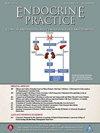Patients With Persistent Hashimoto-Related Symptoms. Dilemmas in Advice-Giving and Self-Selection for Thyroidectomy. An Observational Study
IF 3.7
3区 医学
Q2 ENDOCRINOLOGY & METABOLISM
引用次数: 0
Abstract
Objective
Some Hashimoto-related symptoms, persistent despite medically obtained euthyroidism, are believed to be related to autoimmunity. Total thyroidectomy has proved beneficial for patient-reported outcome measures (PROMs), but with a certain risk of complications. Selection criteria for surgery have not been defined. Molecular evidence supporting an autoimmune cause is lacking, and a placebo effect of surgery cannot be excluded. Short of selection criteria for thyroidectomy and no pathophysiologic model to adequately explain persistent symptoms, we wanted to look into factors that may be related to patients’ decision for surgery, thus aiming to facilitate patient-physician communication on treatment for persistent Hashimoto-related symptoms.
Methods
A total of 177 patients with persistent Hashimoto disease-related symptoms and highly motivated for thyroidectomy completed an 18-month watchful waiting period with biannual consultations before being offered thyroidectomy. PROMs were monitored before and after surgery.
Results
After 18 months of watchful waiting, 131 (74%) of 177 patients proceeded to thyroidectomy whereas 46 declined surgery. There was no difference between the surgery and no-surgery groups regarding sex, age, and thyroid peroxidase antibody levels at 18 months watchful waiting. Compared with the no-surgery group, PROM scores were consistently poorer in the surgery group for all domains in the PROM questionnaires used.
Conclusions
A grace period of 18 months with biannual follow-up before thyroidectomy may be useful to modify exposure to surgery carrying a certain risk of complications. At 18 months, the fatigue score stands out as the most important factor influencing the odds for maintaining a choice to have surgery.
持续桥本相关症状的患者。甲状腺切除术中建议与自我选择的困境。一项观察性研究。
目的:一些桥本相关症状,尽管医学上获得了甲状腺功能亢进,但仍持续存在,被认为与自身免疫有关。全甲状腺切除术已被证明对患者报告结果测量(PROMs)有益,但有一定的并发症风险。手术的选择标准尚未明确。目前缺乏支持自身免疫性病因的分子证据,不能排除手术的安慰剂效应。由于缺乏甲状腺切除术的选择标准,也没有病理生理模型来充分解释持续症状,我们希望研究可能与患者手术决定相关的因素,从而促进患者与医生就治疗持续桥本相关症状进行沟通。方法:177例有持续桥本病相关症状且有高度甲状腺切除术动机的患者在接受甲状腺切除术前完成了18个月的观察等待期,一年两次会诊。术前、术后监测PROMs。结果:观察等待18个月后,177例患者中131例(74%)行甲状腺切除术,46例拒绝手术。在观察等待18个月时,手术组和非手术组在性别、年龄和抗tpo抗体水平方面没有差异。与非手术组相比,在使用的PROM问卷调查的所有领域中,手术组的PROM得分始终较低。结论:甲状腺切除术前有18个月的宽限期,一年两次随访,可能有助于改变手术暴露,有一定的并发症风险。在18个月时,疲劳评分是影响维持手术选择几率的最重要因素。
本文章由计算机程序翻译,如有差异,请以英文原文为准。
求助全文
约1分钟内获得全文
求助全文
来源期刊

Endocrine Practice
ENDOCRINOLOGY & METABOLISM-
CiteScore
7.60
自引率
2.40%
发文量
546
审稿时长
41 days
期刊介绍:
Endocrine Practice (ISSN: 1530-891X), a peer-reviewed journal published twelve times a year, is the official journal of the American Association of Clinical Endocrinologists (AACE). The primary mission of Endocrine Practice is to enhance the health care of patients with endocrine diseases through continuing education of practicing endocrinologists.
 求助内容:
求助内容: 应助结果提醒方式:
应助结果提醒方式:


